What is a water disinfection system?
Water disinfection system plays a vital role in modern society and is one of the key links in ensuring the safety of drinking water. However, for many people, it may not be clear what exactly a water disinfection system is and how it works. This article will take an in-depth look at what water disinfection systems are, how they work, and how they are used in daily life.
What is a water disinfection system?
1. Definition of water disinfection system
Water disinfection system refers to a system that uses chemical methods to attack and eliminate germs (such as bacteria, fungi) and viruses in water. It ensures the safety of drinking water by adding specific disinfectants to kill microorganisms in the water.
2. How the water disinfection system works
The working principle of the water disinfection system is mainly to destroy the cell structure of microorganisms in the water and make them inactive by adding disinfectants. Commonly used disinfectants include chlorine, ozone, ultraviolet light, etc., which can effectively kill bacteria and viruses in water and ensure the safety of water quality.
3. Application scope of water disinfection system
Water disinfection systems are widely used in drinking water treatment, swimming pool water treatment, water treatment in industrial production processes and other fields. It can not only ensure the safety of drinking water in people's daily life, but also ensure the quality of water resources required in industrial production processes.

Common processes and technologies for water disinfection systems
Water disinfection systems use a variety of processes and technologies to achieve water disinfection and purification, including different chemical and physical treatment methods. The following will introduce the common processes and technologies of water disinfection systems as well as their characteristics and applications.
1. Chlorine disinfection
Chlorine disinfection is one of the most common water treatment methods and is achieved by injecting chlorine-containing compounds such as chlorine gas or sodium hypochlorite. Chlorine disinfection is easy to operate and effective, and is widely used in urban water supply systems, swimming pools and other places.
2. Ozone disinfection
Ozone disinfection is an efficient water treatment method that rapidly oxidizes and kills microorganisms and organic matter in the water by injecting ozone gas. Ozone disinfection has the advantages of fast disinfection and no secondary pollution. It is often used in fields such as industrial wastewater treatment and swimming pool water treatment.
3. UV ultraviolet disinfection
UV disinfection uses the high energy of ultraviolet rays to destroy the nucleic acid structure of microorganisms, thereby achieving the purpose of killing germs. UV disinfection does not require the addition of chemicals and does not produce by-products. It is widely used in drinking water treatment and medical and health fields.

What are the common issues and challenges with water disinfection systems?
1. Disinfectant residue
Water disinfection systems may leave a certain amount of disinfectant residue during the disinfection process, which may have an impact on human health. Therefore, how to control the residual amount of disinfectants has become one of the important issues faced by water disinfection systems.
2. Emergence of drug-resistant microorganisms
Long-term use of the same disinfectant may cause microorganisms in the water to develop resistance, thereby reducing the effectiveness of the disinfectant. How to deal with the emergence of drug-resistant microorganisms has become another problem for water disinfection systems.
3. Selection and use of disinfectants
Different disinfectants have different killing effects on microorganisms in water. Therefore, how to select and use appropriate disinfectants has become one of the important issues that need to be solved in water disinfection systems.

How to improve the efficiency and safety of water disinfection systems?
1. Develop scientific and reasonable standards for the use of disinfectants
The water disinfection system needs to establish scientific and reasonable standards for the use of disinfectants to ensure that the amount and concentration of disinfectants are within a safe range while ensuring the disinfection effect.
2. Introduce new disinfection technology
In view of the problems and challenges existing in the water disinfection system, new disinfection technologies can be introduced, such as ozone disinfection, ultraviolet disinfection, etc., to improve the efficiency and safety of the disinfection system.
3. Strengthen supervision and management
Government departments need to strengthen the supervision and management of the water disinfection system, establish a sound monitoring system and emergency response mechanism, promptly discover and solve problems in the water disinfection system, and ensure the safety of people's drinking water.
Water disinfection systems use chemical methods to attack and eliminate germs (fungi, bacteria) and viruses. The process of these systems differs from preservative types which do not allow microbial substances to spread through various means rather than completely destroying them




